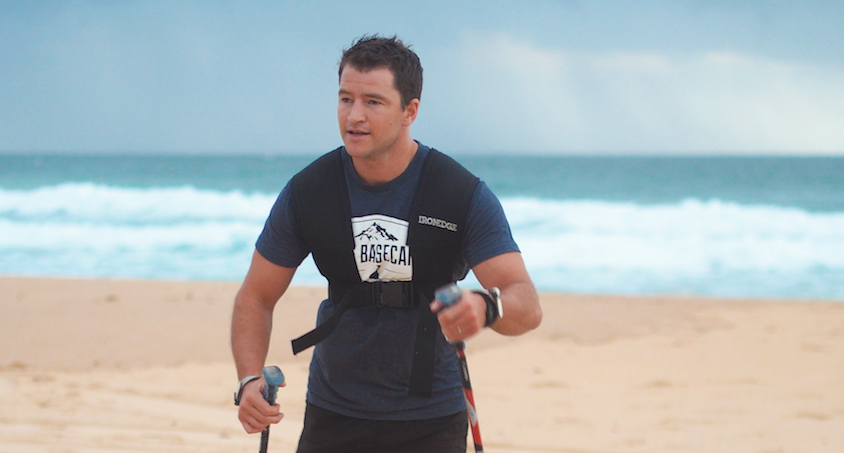Back in issue 154 you might remember the below table:
You’ll notice that the specific, or as we call it ‘peak’, phase is much shorter than your base. Especially when you’re short on lead-in time for your trip, it’s important to build your base fitness, not your peak. As a simple analogy to follow, your base fitness training can be thought of as a foundation. There’s no point to building anything without a strong foundation, right?
But today we’re assuming you’ve all been keeping up with your base fitness and instead we’ll take a closer look at building specificity into your adventure training routine for trek, trail, mountaineering or whatever it is you love doing.
For this element of the training schedule, the adventurer tries to emulate the stresses and strains of the objective activity as much as possible. The intensity ramps up, but there are also longer recovery periods to compensate.
In the case of multiday bushwalkers and mountaineers looking forward to that next big trip, it’s this phase of fitness preparation where you would consider loading up your pack and getting in some big days of walking. Trail runners would be looking to top out their training volume (kilometres covered), while also increasing their hill and stair repeats (see issue 155 for notes on training for trailrunning).
Looking specifically at the mountaineers and bushwalkers, this type of activity-specific training may be referred to as ‘pack work’, while some use the military term ‘rucking’. For mountaineers, the focus is likely to lean more towards hill climbing with up to an additional 30 percent of the individual’s bodyweight of pack weight. Bushwalkers/trekkers would instead consider a maximum of 20 percent. Regardless of your perceived level of fitness, do not jump straight into these maximum loads. Instead, build up to the maximum incrementally during end of the base phase.
It’s during peak phase that really builds mental toughness. Weekends of back-to-back hikes that go late into the night are meant to be mentally as well as physically exhausting. For the alpine technical mountaineer, this may be a long day of mixed climbing that’s not be technically difficult, just a couple of pitches that are physically strenuous enough to let you know you’ve been there. These are done repeatedly before rucking for an hour or two, and then heading back to the crag to do it all again. Backing this up the next day with a long rucking session will pay dividends.
If you are looking at a polar trip or some serious ski touring, you will be pulling a pulk (sled system). You will have already been pulling light tyres during your base phase, now we really start to load up using bigger tyres. Beaches and fire trails are perfect for this kind of work.
Because this kind of work takes it out of you, you really need to make sure that you pay attention to recovery – more training is not more effective. Have a good couple of days off after doing exercises like this and be sure to refuel. Really make sure you are eating enough to cover your energy expenditure. Nutrition is a massive subject in itself; one that I hope we can discuss in a future column.
During the peak phase, cut back on the amount of strength training you are doing to once per week, but increase the amount of mobility work you are doing. Your overall training volume is peaking but it is mainly outdoors, which is great because that’s where we love to be.
Spend time on your body; the more you help it recover from those big sessions, the better your results. Some soft tissue work, massage or physio once a week or fortnight is ideal. Most importantly, look after your legs; they have a long way to carry you yet.
WARNING:
Rucking is hard on the knees (don’t go over 30 percent bodyweight in load). One way to mitigate this strain is to do big hills close to a source of water, filling water containers at the bottom of the hill and loading them into your pack in order to achieve the desired weight. The hill is climbed at top speed before emptying the water at the top. This alleviates pressure on the knees as it’s the action of moving downhill under load that carries the most risk of injury.
Another alternative that cuts out risky descents is to find your nearest altitude training chamber (most major cities will have a gym that offers this service). Use progressive inclines on a treadmill while reducing oxygen under load. This method is effective, but tends to be used only by professional athletes or those who take their training very seriously.
As you might have guessed rucking is very effective training, but few people find it enjoyable!
The Taper
Two weeks prior to your trip, all the hard work is done and it’s time to cut your training volume in half. Get outside and walk and run at an enjoyable pace. Keep moving, but slow it down. Take your time, enjoy the view and smell the eucalypts!
I see too many people training hard right the way up until they leave for a challenging trip. They are tired before they start their expedition. The whole point of training is preparation – getting us to the best point possible so we can be the best we can be and enjoy whatever endeavour we choose to undertake. The taper is like charging a battery, you are as strong as you are going to be, so now we want to be fully charged and ready to go!
This article originally featured in Wild issue 156. Subscribe today to receive the latest edition.



